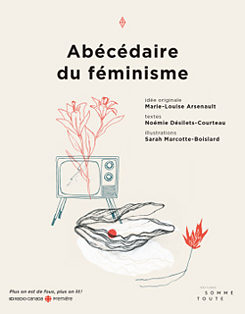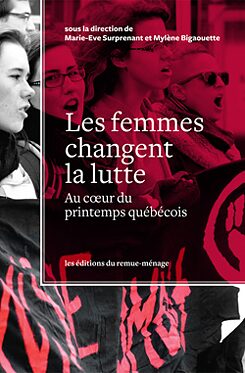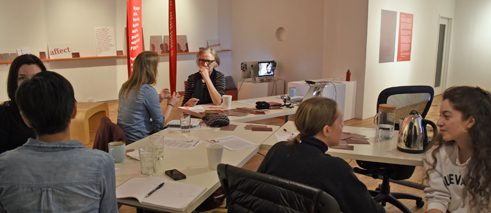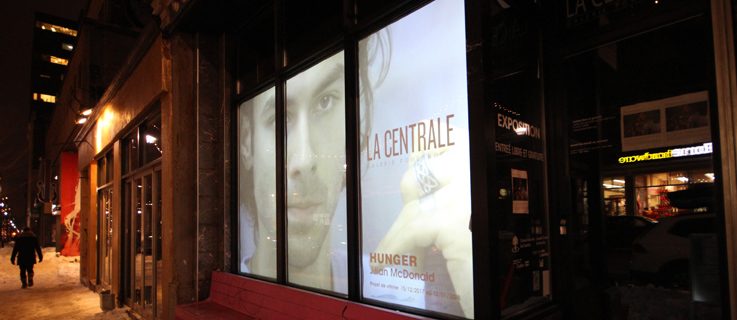If you want to grasp feminism in Quebec and portray it in an article, you have to ask yourself several questions, such as, “Where do I start?” Since art and culture constitute my personal and professional foundations I automatically direct my thinking towards the artistic spheres that surround me. Hence I suggest an overview of feminism in Quebec, similar to a general introduction, characterised by my individual point of view and fed by my experiences and my social circles.
In daily life, feminism can be found everywhere and nowhere at the same time. On a large scale it has slowly taken roots for several years. The current conditions of women in Quebec are, among other factors, an outcome of the past, where the fight of several feminists throughout history resonates until the present. This fight is inching forward towards equality and respect between men and women. The milestones that make up the history of feminism provide a certain perspective of today’s context. In October 2017, the historian and scholar Micheline Dumont received the Governor General’s Award in Commemoration of the Person’s Case. This award recognises the involvement of Canadian women in issues of gender equality. For a similar event you have to go back all the way to 1929 when five Canadian feminists (Emily Murphy, Nellie McClung, Irene Parlby, Louise McKinney, and Henrietta Muir Edwards) succeeded in getting women recognised as legal persons by the Canadian Constitution Act. Micheline Dumont, who was very involved in women’s issues, specialised in the history of women in Quebec. In 2003, her history of feminism in Quebec was published, entitled La pensée féministe au Québec: Anthologie 1900-1985 (Feminist Thinking in Quebec. Anthology 1900-1985), a book that Dumont co-authored with Louise Toupin.
In the Shadow of Words
We tend to forget that women in Quebec were granted certain rights only a few decades ago. The right of women in Quebec to vote is one of them. While Canadian women on the federal level received their right to vote in 1920 as a reward for their participation in the war effort between 1914 and 1918, and thus in 1922, women in all Canadian provinces were given the right to vote except in Quebec. In 1921, the Provincial Suffragette Committee was formed, with Marie Gérin-Lajoie and Anna Lyman as presidents. In February 1922, 400 women demanded their right to vote in front of the Quebec Parliament. Thérèse Casgrain, one of the movement’s leaders, revitalised the Provincial Committee in 1929 under the name of Women’s Rights League. Thanks to its persistence, women in Quebec were given voting rights in 1940.
We owe the thriving of women in Quebec and their emancipation to feminists, and to numerous female artists, thinkers, cultural organisations and others. One author to point out is Madeleine Gagnon, who in her work depicts the human existence. A poet, novelist and essayist, she has written about 40 books since 1968, and received numerous awards, including, in 2002, the
Prix Athanase-David for the body of her work. In 2007, the retrospective of her poetry was published under the title
À l'ombre des mots. Poèmes 1964-2006 (In the Shadow of Words. Poems 1964-2006). The journalist Monique Durand who commissioned Gagnon to write the book
Les femmes et la guerre (Women in a World at War), describes why she called upon Gagnon. “I chose Madeleine Gagnon for the way she tells a story and for her way of thinking about life, death, and the female and male character. She is someone who can write about complexity, about the great complexity of the world and of feelings.” (from: Gagnon, Madeleine. 2000.
Les femmes et la guerre. Montreal, vlb éditeur, p. 14.). In 1999 and 2000, the two women traveled together through the Balkans to the Middle East and then on to South East Asia and interviewed women living in war zones. The testimonials resulting from these encounters reflect immense suffering but they also furnish valuable lessons in courage and humanity.
often risky but always necessary
 Abécédaire du féminisme (ABC of Feminism)
| © Éditions Somme Toute
Abécédaire du féminisme (ABC of Feminism)
| © Éditions Somme Toute
Also in the realm of writing,
L’Abécédaire du féminisme (The Feminist Primer), published in 2016, is an indispensable work on feminism. The book, inspired by an episode of the same name of the literary program
Plus on est de fous, plus on lit! (The Crazier You Are the More You Read!) by Radio-Canada, is a complete lexicon of the feminist movement. The texts by Noémie Désilets-Courteau, with illustrations by Sarah Marcotte-Boislard, draw a panoramic view of the major feminist topics (equality, motherhood, gender, sexuality, etc.) while profiling the pioneers and feminists in different stages of the feminist movement.
Quebec has a multitude of committed literary outlets. One important example is, without a doubt,
Les Éditions du Remue-ménage whose mission is to “move forward the reflection on the conditions of women and gender issues, while exploring innovative themes and approaches, introducing new writers and supporting the work of established authors. The books we publish are often risky but always necessary.” (from: Website of
Les Éditions du Remue-ménage, March 3, 2018.). Worth mentioning is
Les femmes changent la lutte.
Au cœur du printemps
 Les femmes changent la lutte ( Women Are Changing the Fight)
| © Les Éditions du Remue-ménage
québécois
Les femmes changent la lutte ( Women Are Changing the Fight)
| © Les Éditions du Remue-ménage
québécois (Women Are Changing the Fight. In the Centre of the Quebec Spring), an anthology published in 2013 based on the publisher’s other titles. Karine Philibert, a feminist, activist and mental health nurse, co-authored the article “
Femmes au front: les infirmières dans la lutte” (“Women at the Front: Nurses in the Fight”). As a member of the nurses’ collective against the increase of tuition fees, Karine Philibert delivers a testimonial of her civic impact and participation during the student strike in the spring of 2012. Philibert describes the difficulties she encountered in the context of social, political, police and other forms of oppression, and the stark judgment that she and her nurse colleagues were facing. Some health care professionals even criticised the nurses’ public appearance and argued that nursing should be apolitical.
The picture of the political and feminist landscape would be incomplete without mentioning the artistic expression by indigenous people, both Métis and First Nations. These women work hard to receive recognition for their culture and make it known, while casting light on their heritage, which has been suppressed for so long. Two women in particular stand out for their impact. Lindsay Nixon, who studies art history at Concordia University, is a Cree-Métis-Saulteaux curator and writer. In 2017 she was nominated the first indigenous editor-at-large for the
Canadian Art magazine, and one of her specialties is a critical approach to the way indigenous art topics are being presented. Nixon is also one of the founders of the independent publishing house
Critical Sass Press. Alanis Obomsawin, a member of the Abenaki Nation, has been making documentary films since the 1960s. In 2017, her 50th film was released,
Our People Will Be Healed, in which she shows a Cree community in Manitoba, their history, language and culture.
There are also locations and social gathering places that perpetuate feminist values and concerns. The inviting book store Euguelionne, which specialises in women’s literature and feminist works (and also offers queer, lesbian, gay, bisexual, trans, intersex, asexual and gender-free, two-spirited, anti-racist, anti-colonial titles, etc.) organises dialogues and discussions, book launches, and round tables about topics that really touch these communities.
Artist-run centres for female artists were created in Montreal in the 1970s and 1990s with the idea to offer a place for feminist and genre activities in art world dominated by men.
La Centrale galerie Powerhouse, which has been around since 1974, is dedicated to the outreach and development of multidisciplinary feminist practices, and supports initiatives and artists with otherwise little visibility in the mainstream cultural institutions. Its programs offer a voice and a platform for the dialogue among feminists, conveying ideas ranging from intersectionality to social justice.
 Unlock: Expériences genrées des technologies (Technological gender experiences) with Cornelia Sollfrank at the Studio XX
| © Martine Frossard
Unlock: Expériences genrées des technologies (Technological gender experiences) with Cornelia Sollfrank at the Studio XX
| © Martine Frossard
In multimedia arts, Studio XX, founded in 1996 by communications professor Kim Sawchuck, filmmaker Patricia Kearns, sound artist Kathy Kennedy, and cybernet specialist Sheryl Hamilton also offers a public space with artist studios, exhibits and activities that take a critical and engaged approach to current expressions by artists who identify as women, transgender or dissidents. From 2004 to 2015, Studio XX produced 32 issues of
.dpi, a feminist art and online digital literary magazine. It served as a platform for creative, critical and socially engaged exchange about feminism and technology.
Feminism in Quebec today is the outcome of a long travail that remains under way. There is still a lot to be done before real equality is achieved. To preserve what has been achieved and create more justice, it is desirable that dynamic activities around feminism are supported and encouraged. Education, research, solidarity and sharing are some of the keys to success.
